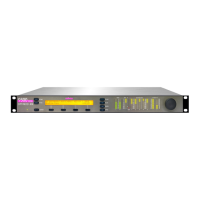OPTIMOD-AM DIGITAL INTRODUCTION
1-17
mission bandwidth from 5 kHz to 9.5 kHz will produce virtually no audible differ-
ence on these radios.)
Antenna System
AM antenna systems, whether directional or non-directional, frequently exhibit in-
adequate bandwidth or asymmetrical impedance. Often, a system will exhibit both
problems simultaneously.
An antenna with inadequate bandwidth couples RF energy into space with progres-
sively less efficiency at higher sideband frequencies (corresponding to higher modu-
lation frequencies). It reflects these higher-frequency sideband components back in-
to the transmitter or dissipates them in the tuning networks. This not only causes
dull sound on the air (and defeats OPTIMOD-AM's principal advantage: its ability to
create a highly pre-emphasized signal without undesirable side effects), but it also
wastes energy, can cause distortion, and can shorten the life of transmitter compo-
nents.
Asymmetrical impedance is the common point impedance's not being symmetrical
on either side of the carrier frequency when plotted on a Smith Chart. This problem
can cause transmitter misbehavior and sideband asymmetry, resulting in on-air dis-
tortion in receivers with envelope detectors.
Both of these limitations can cause severe problems in AM stereo and even worse
ones in HD-AM installations.
Neither problem is easily solved. Unless the radio station engineer is a knowledge-
able antenna specialist, a reputable outside antenna consultant should be employed
to design correction networks for the system.
Note that many antenna systems are perfectly adequate, particularly for ordinary
mono analog transmission. However, if the transmitter sounds significantly brighter
and/or cleaner into a dummy load than it does into your antenna, the antenna sys-
tem should be evaluated and corrected if necessary.
As noted above, if your circumstances or budget precludes correcting your antenna's
bandwidth and/or symmetry, you will often get lower on-air distortion if you set
OPTIMOD-AM's low-pass filter to a lower frequency than the maximum permitted
by the government. Because OPTIMOD-AM's output bandwidth is easily adjustable
in real time, it is very easy to experiment to see which bandwidth gives the best au-
dio quality on an average AM radio, given the quality of your transmitter and an-
tenna.
Using Lossy Data Reduction in the Studio
Many stations are now using lossy data reduction algorithms like MPEG-1 Layer 2 to
increase the storage time of digital playback media. In addition, source material has
often been passed through a lossy data reduction algorithm, whether from satellite

